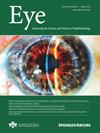Socioeconomic and environmental factors associated with glaucoma in an African Ancestry Population: findings from the Primary Open-Angle African American Glaucoma Genetics (POAAGG) study
IF 2.8
3区 医学
Q1 OPHTHALMOLOGY
引用次数: 0
Abstract
Glaucoma is the leading cause of irreversible blindness, disproportionately affecting individuals of African ancestry. Limited research has examined the impact of neighbourhood quality and socioeconomic factors on primary open-angle glaucoma (POAG) risk in this population. This study aims to address these gaps by evaluating associations between ocular health and neighbourhood characteristics using geospatial data. We conducted a case-control study with 5192 African ancestry individuals from the Philadelphia area using data from the Primary Open-Angle African American Glaucoma Genetics (POAAGG) study. Geocoded U.S. Census data were merged with individual-level demographics and neighbourhood-level measures, including air quality, food accessibility, and socioeconomic indicators, to assess their association with glaucoma risk and severity. The study included 3039 controls (58.5%) and 2153 POAG cases (41.5%). Higher POAG risk was associated with older age (OR 1.72 per 10-year increase, p < 0.001), male gender (OR 2.04, p < 0.001), lower BMI (OR 0.87 per 10 kg/m2 increase, p = 0.003), and nonuse of alcohol (OR 0.56 for alcohol use, p < 0.001). Low food access was more common in controls (OR 0.86, p = 0.03), and severe POAG cases were associated with lower homeownership rates (OR 0.95 per 10% increase, p = 0.049). However, most socioeconomic and environmental factors (air quality, education, income, occupation, family structure) were not significantly linked to POAG risk or severity. Socioeconomic status did not significantly protect against POAG in African ancestry individuals. Individual factors were more influential, suggesting neighbourhood and socioeconomic factors may have a lesser impact than previously hypothesised.非洲血统人群中与青光眼相关的社会经济和环境因素:来自初级开角非洲裔美国人青光眼遗传学(POAAGG)研究的发现
背景/目的:青光眼是不可逆性失明的主要原因,对非洲裔人群的影响尤为严重。有限的研究调查了社区质量和社会经济因素对该人群原发性开角型青光眼(POAG)风险的影响。本研究旨在通过使用地理空间数据评估眼健康与邻里特征之间的关系来解决这些差距。研究对象/方法:我们对来自费城地区的5192名非洲裔个体进行了病例对照研究,使用的数据来自初级开角非裔美国人青光眼遗传学(POAAGG)研究。地理编码的美国人口普查数据与个人层面的人口统计数据和社区层面的措施(包括空气质量、食物可及性和社会经济指标)相结合,以评估其与青光眼风险和严重程度的关系。结果:纳入对照组3039例(58.5%),POAG 2153例(41.5%)。较高的POAG风险与年龄较大(每10年增加1.72,p 2增加,p = 0.003)和不使用酒精(使用酒精的OR为0.56,p)相关。结论:社会经济地位对非洲血统个体的POAG没有显著保护作用。个人因素的影响更大,这表明社区和社会经济因素的影响可能比之前假设的要小。
本文章由计算机程序翻译,如有差异,请以英文原文为准。
求助全文
约1分钟内获得全文
求助全文
来源期刊

Eye
医学-眼科学
CiteScore
6.40
自引率
5.10%
发文量
481
审稿时长
3-6 weeks
期刊介绍:
Eye seeks to provide the international practising ophthalmologist with high quality articles, of academic rigour, on the latest global clinical and laboratory based research. Its core aim is to advance the science and practice of ophthalmology with the latest clinical- and scientific-based research. Whilst principally aimed at the practising clinician, the journal contains material of interest to a wider readership including optometrists, orthoptists, other health care professionals and research workers in all aspects of the field of visual science worldwide. Eye is the official journal of The Royal College of Ophthalmologists.
Eye encourages the submission of original articles covering all aspects of ophthalmology including: external eye disease; oculo-plastic surgery; orbital and lacrimal disease; ocular surface and corneal disorders; paediatric ophthalmology and strabismus; glaucoma; medical and surgical retina; neuro-ophthalmology; cataract and refractive surgery; ocular oncology; ophthalmic pathology; ophthalmic genetics.
 求助内容:
求助内容: 应助结果提醒方式:
应助结果提醒方式:


